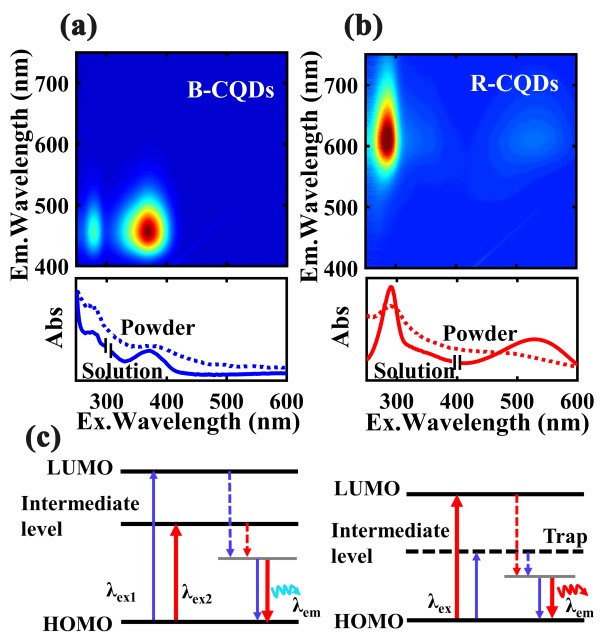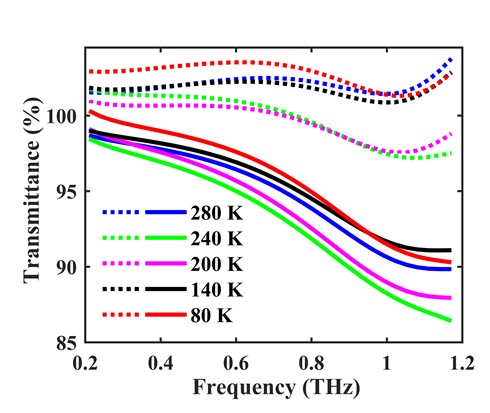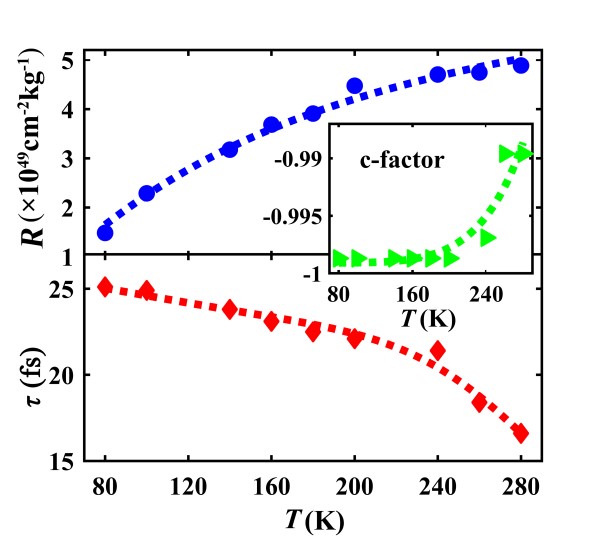Recently, researchers led by Prof. XU Wen from the Institute of Solid State Physics, Hefei Institutes of Physical Science (HFIPS), along with their collaborators from the Southwest University in Chongqing, applied the Terahertz time domain spectroscopy (THz TDS) for studying the optoelectronic properties of fluorescent carbon quantum dots (FQCDs).
Carbon quantum dots (CQDs) are a class of zero-dimensional carbon materials, which have drawn great attention due to their outstanding optical and optoelectronic properties. It is an environmental-friendly material promising for realization of full-color lighting and displays, in which case, the FCQDs should be used in solid state.
This time, the research group prepared two kinds of FCQDs, which could emit bright blue (B-CQDs) and red (R-CQDs) lights in solutions under optical excitation. After studying the THz optoelectronic response of dry FCQD particles with temperature range from 80 to 280 K, they found that R-CQDs behaved like an optical insulator in 0.2 – 1.2 THz range, while B-CQDs experienced insulator-to-semiconductor transition with increasing THz radiation frequency and temperature. Optical conductance and key physical parameters of FCQDs could be deduced from THz transmittance spectra. Their results explained the mechanism of this phenomenon and would lead to more sufficient understanding of the basic physical properties of FCQDs.
This is the first time scientists applied the THz TDS to the investigation of dry CQDs. And an interesting phenomenon of insulator-to-semiconductor transition in FCQDs in THz bandwidth was observed experimentally in the study, indicating that the CQDs can be utilized to realize the advanced THz optoelectronic materials and devices.
This work was supported by the National Natural Science foundation of China (U2067207, U1930116, 81127901) and the Center of Science and Technology of Hefei Academy of Science (2016FXZY002).
Link to the paper: Optically induced insulator-to-semiconductor transition in fluorescent carbon quantum dots measured by terahertz time-domain spectroscopy

Fig.1. PL and UV-Vis absorption spectra are shown in (a) for B-CQDs and in (b) for R-CQDs. (c) The diagram of the energy levels and the electronic transition channels for PL emission from B- (left panel) and R-CQDs (right panel). (Image by SONG Dan)

Fig. 2. Spectra of the transmittance induced by R-CQDs (dotted curves) and B-CQDs (solid curves) at different temperatures as indicated. (Image by SONG Dan)

Fig.3. The carrier density related parameter R=gne/m* (upper panel), the carrier relaxation time τ (lower panel) and the carrier localization factor c (inset) as a function of temperature for B-CQDs. The symbols are obtained via fitting the experimental results with the DSF, the curves are given with theory fitting. (Image by SONG Dan)
Contact:
ZHAO Weiwei
Hefei Institutes of Physical Science (http://english.hf.cas.cn/)
Email: annyzhao@ipp.ac.cn
 Tel: +86-551-65591206
Tel: +86-551-65591206
 Fax: +86-551-65591270
Fax: +86-551-65591270
 Emai: zhous@hfcas.ac.cn
Emai: zhous@hfcas.ac.cn
 350 Shushanhu Road
350 Shushanhu Road